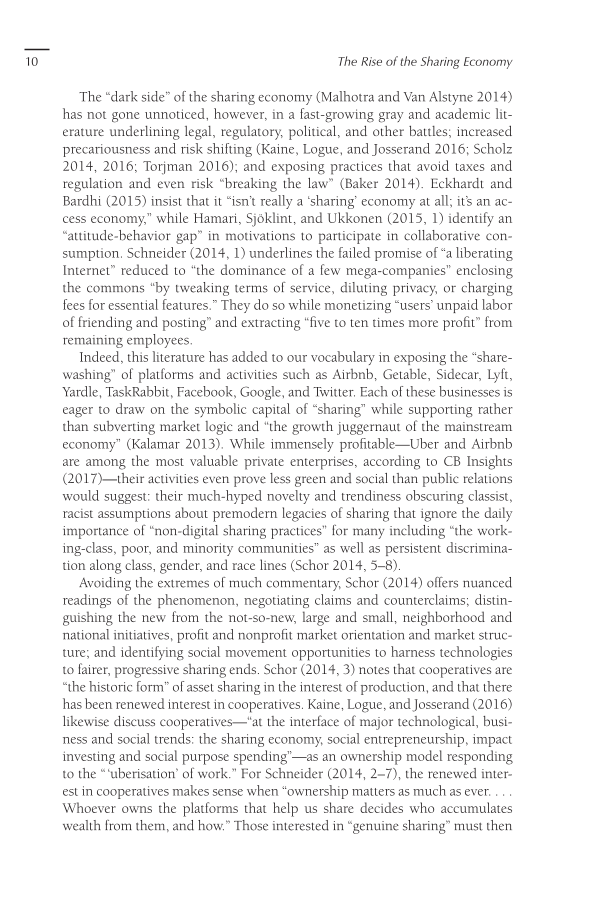10 The Rise of the Sharing Economy
The “dark side” of the sharing economy (Malhotra and Van Alstyne 2014)
has not gone unnoticed, however, in a fast-growing gray and academic lit-
erature underlining legal, regulatory, political, and other battles; increased
precariousness and risk shifting (Kaine, Logue, and Josserand 2016; Scholz
2014, 2016; Torjman 2016); and exposing practices that avoid taxes and
regulation and even risk “breaking the law” (Baker 2014). Eckhardt and
Bardhi (2015) insist that it “isn’t really a ‘sharing’ economy at all; it’s an ac-
cess economy,” while Hamari, Sjöklint, and Ukkonen (2015, 1) identify an
“attitude-behavior gap” in motivations to participate in collaborative con-
sumption. Schneider (2014, 1) underlines the failed promise of “a liberating
Internet” reduced to “the dominance of a few mega-companies” enclosing
the commons “by tweaking terms of service, diluting privacy, or charging
fees for essential features.” They do so while monetizing “users’ unpaid labor
of friending and posting” and extracting “five to ten times more profit” from
remaining employees.
Indeed, this literature has added to our vocabulary in exposing the “share-
washing” of platforms and activities such as Airbnb, Getable, Sidecar, Lyft,
Yardle, TaskRabbit, Facebook, Google, and Twitter. Each of these businesses is
eager to draw on the symbolic capital of “sharing” while supporting rather
than subverting market logic and “the growth juggernaut of the mainstream
economy” (Kalamar 2013). While immensely profitable—Uber and Airbnb
are among the most valuable private enterprises, according to CB Insights
(2017)—their activities even prove less green and social than public relations
would suggest: their much-hyped novelty and trendiness obscuring classist,
racist assumptions about premodern legacies of sharing that ignore the daily
importance of “non-digital sharing practices” for many including “the work-
ing-class, poor, and minority communities” as well as persistent discrimina-
tion along class, gender, and race lines (Schor 2014, 5–8).
Avoiding the extremes of much commentary, Schor (2014) offers nuanced
readings of the phenomenon, negotiating claims and counterclaims; distin-
guishing the new from the not-so-new, large and small, neighborhood and
national initiatives, profit and nonprofit market orientation and market struc-
ture; and identifying social movement opportunities to harness technologies
to fairer, progressive sharing ends. Schor (2014, 3) notes that cooperatives are
“the historic form” of asset sharing in the interest of production, and that there
has been renewed interest in cooperatives. Kaine, Logue, and Josserand (2016)
likewise discuss cooperatives—“at the interface of major technological, busi-
ness and social trends: the sharing economy, social entrepreneurship, impact
investing and social purpose spending”—as an ownership model responding
to the “ ‘uberisation’ of work.” For Schneider (2014, 2–7), the renewed inter-
est in cooperatives makes sense when “ownership matters as much as ever. . . .
Whoever owns the platforms that help us share decides who accumulates
wealth from them, and how.” Those interested in “genuine sharing” must then





























































































































































































































































































































